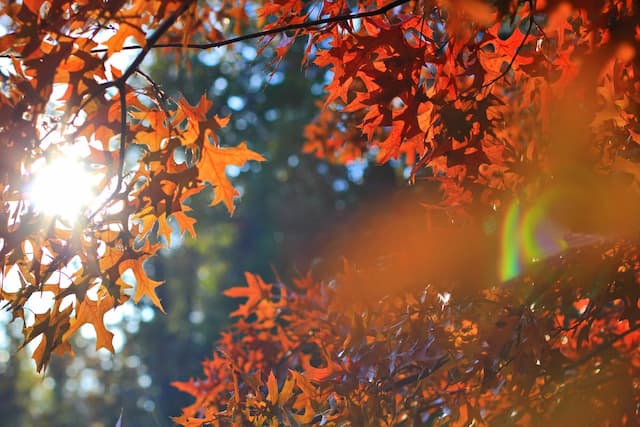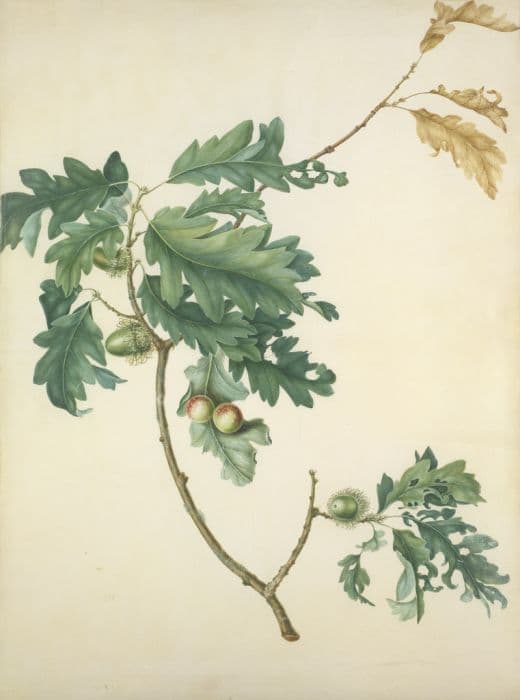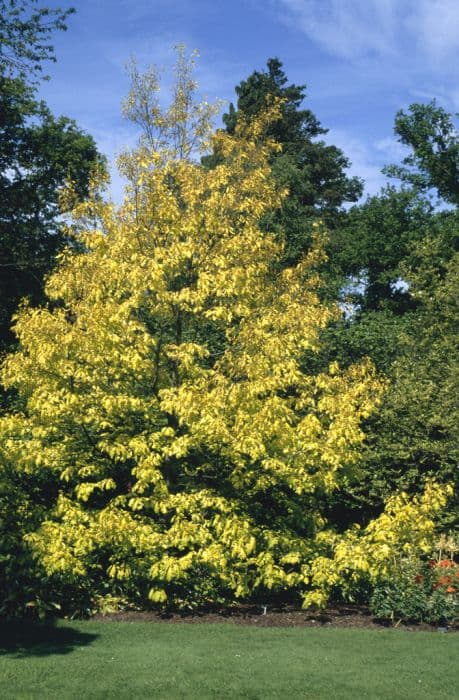European Beech Fagus sylvatica 'Dawyck'

ABOUT
The Fagus sylvatica 'Dawyck', commonly known as the European beech 'Dawyck', features a striking, columnar form that offers a sense of elegance and verticality to landscapes without taking up much horizontal space. Its leaves, which unfurl in a vibrant shade of green in the spring, are delicate and oval with a slightly wavy edge and a pointed tip. As the seasons change, the foliage transforms into a rich coppery color that provides a stunning autumnal display before the leaves shed. The bark of the European beech 'Dawyck' is smooth and silver-gray, providing year-round interest even after the leaves have fallen. During the spring, small, inconspicuous flowers can be found on the tree, which later give way to spiky fruits known as beechnuts. These nuts can attract various forms of wildlife, offering an additional layer of interaction with the natural world. The tree's compact and upright nature makes it a good choice for landscaping in areas where space might be limited but vertical growth is desired. Its ability to maintain a relatively narrow shape is one of its distinguishing characteristics.
About this plant
 Names
NamesFamily
Fagaceae
Synonyms
Dawyck Beech, European Beech, Common Beech
Common names
Fagus sylvatica 'Dawyck'.
 Toxicity
ToxicityTo humans
The European beech, the most common common name for Fagus sylvatica 'Dawyck', is not known to be toxic to humans. Ingesting parts of the plant is unlikely to cause poisoning or adverse health effects.
To pets
The European beech is not considered toxic to pets. Ingesting parts of this plant should not lead to poisoning or present significant health risks for animals. However, as with any non-food plant material, ingestion of large quantities might cause mild stomach upset due to the physical irritation of the digestive tract.
 Characteristics
CharacteristicsLife cycle
Perennials
Foliage type
Deciduous
Color of leaves
Green
Height
50 feet (15 meters)
Spread
15 feet (4.5 meters)
Plant type
Tree
Hardiness zones
4
Native area
Europe
Benefits
 General Benefits
General Benefits- Aesthetic Appeal: Fagus sylvatica 'Dawyck', commonly known as Dawyck Beech, is a tall, narrow tree with a distinct columnar shape, providing architectural interest in landscapes.
- Seasonal Interest: It offers year-round visual interest with its bright green leaves in spring, dense shade in summer, golden bronze fall foliage, and smooth, silvery-gray bark in winter.
- Shade Provider: Its dense canopy can create substantial shade, making it valuable for cooling nearby spaces and providing shelter from the sun.
- Wildlife Habitat: The tree can serve as a habitat and food source for wildlife, including birds and small mammals who may eat the beech nuts produced.
- Drought Tolerance: Once established, Dawyck Beech has a certain degree of drought tolerance, making it suitable for regions with occasional water scarcity.
- Soil Stabilization: Its extensive root system can help prevent soil erosion on slopes or in areas prone to erosion.
- Low Maintenance: The tree requires relatively low maintenance once established, without the need for regular pruning or complicated care routines.
- Longevity: Beech trees are known for their long lifespan, with Dawyck Beech capable of living for several centuries under optimal conditions.
- Versatility in Landscaping: It is suitable for a range of landscaping applications, including as a specimen tree, in avenues, or in narrow spaces due to its upright growth habit.
 Medical Properties
Medical PropertiesThis plant is not used for medical purposes.
 Air-purifying Qualities
Air-purifying QualitiesThis plant is not specifically known for air purifying qualities.
 Other Uses
Other Uses- Fagus sylvatica 'Dawyck', also known as Dawyck Beech, can be used as a natural sound barrier due to its dense foliage, effectively reducing noise pollution when planted in rows along busy streets or highways.
- The wood of Dawyck Beech can be used in the construction of musical instruments such as drums and guitars, owing to its ability to resonate sound.
- Dawyck Beech trees are sometimes planted in large estates or parks as mazes or living labyrinths, providing both an aesthetic appeal and a recreational activity for visitors.
- Wood turners value the wood from this beech for creating decorative items such as wooden bowls, vases, and other finely turned pieces.
- The spring foliage of the Dawyck Beech can be used as a natural dye for fabrics, giving a light green hue to the textile material.
- Its dense canopy can be strategically planted to provide windbreaks that protect crops, soil, and smaller plants from strong winds.
- Carvers and sculptors may use the timber from Dawyck Beech to create detailed sculptures, as the wood has a fine grain that is ideal for intricate work.
- The tree's tall, narrow form can be utilized in landscape photography as a striking vertical element in composition, often used to contrast against rolling hills or wide skies.
- Dense hedges of Dawyck Beech can be utilized in wildlife gardens to create safe nesting sites and habitats for birds and other fauna.
- When planted in large pots or containers, young Dawyck Beech trees can be used for bonsai, embracing the art of miniature tree cultivation.
Interesting Facts
 Feng Shui
Feng ShuiThe European beech is not used in Feng Shui practice.
 Zodiac Sign Compitability
Zodiac Sign CompitabilityThe European beech is not used in astrology practice.
 Plant Symbolism
Plant Symbolism- Strength & Endurance: Fagus sylvatica 'Dawyck', commonly known as the European beech or simply beech, is often associated with strength due to its hard wood and its impressive size it can achieve over its long lifespan.
- Wisdom & Knowledge: The beech has traditionally been connected with wisdom, as beech tablets were used as writing surfaces in ancient times. This association is reflective of a desire for learning and the preservation of knowledge.
- Patience & Tolerance: As a tree that takes many years to reach maturity, it symbolizes patience. Its ability to thrive in various types of soils also demonstrates tolerance.
- Prosperity: The European beech is symbolic of prosperity as well, perhaps because of its abundance of nuts that provide sustenance to wildlife and were used as a food source in the past by humans.
 Water
WaterEuropean Beech trees, or more specifically the 'Dawyck' variety, typically favor consistent moisture but require good drainage to prevent waterlogging. During the first growing season, you should water them deeply once a week to help establish an extensive root system unless there is significant rain that week. After establishment, reduce watering to every two weeks, supplying about 1 to 1.5 gallons per watering depending on rainfall and soil conditions. During hot, dry periods, weekly watering may become necessary again. It is critical to adjust the watering frequency based on weather conditions, seasonal changes, and the tree's growth stage.
 Light
LightThe European Beech ('Dawyck') thrives in a location with full sun to partial shade. Ideally, it should receive at least four to six hours of direct sunlight daily for optimal growth and development, with some protection from the intense afternoon sun if possible. When choosing a planting spot, ensure it can accommodate the tree's mature size and allows for adequate light exposure throughout the day.
 Temperature
TemperatureEuropean Beech trees, like the 'Dawyck' variety, are hardy and can survive in temperatures as low as -20°F and as high as 90°F. They grow best in a temperate climate with a preferred average temperature ranging between 50°F and 70°F. These trees can adapt to a variety of climate conditions but should not be exposed to extreme heat for prolonged periods.
 Pruning
PruningPruning the European Beech ('Dawyck') is essential to maintain its shape, remove any damaged or diseased branches, and encourage healthy growth. It is best to prune during the dormant season, ideally in late winter before new growth starts. Thinning the canopy every few years allows light and air to reach the inner branches. Moderate pruning should be done annually to keep the desired form, being careful not to remove more than one-third of the tree's branches at a time.
 Cleaning
CleaningNot needed
 Soil
SoilDawyck Beech thrives in well-drained, fertile soil with a slightly acidic to neutral pH range of 5.0-7.0. The ideal soil mix can comprise of loam, sand, and some organic matter to enhance fertility and moisture retention.
 Repotting
RepottingDawyck Beech trees, being large and long-lived, are not typically repotted. Instead, they are planted in a location where they can grow undisturbed for many years.
 Humidity & Misting
Humidity & MistingDawyck Beech prefers moderate humidity levels, consistent with outdoor conditions in its natural environment. It is adaptable and doesn't require specific humidity adjustments.
 Suitable locations
Suitable locationsIndoor
Growing Dawyck Beech indoor is not advisable due to its large size.
Outdoor
Plant in well-draining soil, full sun to partial shade, protect from wind when young.
Hardiness zone
Dawyck Beech is suitable for 4-7 USDA hardiness zones.
 Life cycle
Life cycleThe common name for Fagus sylvatica 'Dawyck' is Dawyck Beech. The life cycle begins with a germination stage, where the seeds, or beechnuts, usually require stratification to break dormancy before sprouting. Upon sprouting, the seedling stage is characterized by the emergence of the first leaves and root system. Throughout several years of growth, the tree enters a juvenile phase, rapidly establishing a good structural form. As it matures into adulthood after about 30-40 years, it will be capable of producing its own viable seeds to propagate the next generation. The Dawyck Beech can live for several hundred years, eventually reaching a senescence phase where growth slows, and the tree may become more susceptible to disease and environmental stress before dying.
 Propogation
PropogationPropogation time
Late winter-early spring
The European Beech 'Dawyck' is commonly propagated by seed, but the most popular method is to graft selected cultivars onto rootstock of the same species to ensure the desirable characteristics of 'Dawyck' are replicated. For successful grafting, the procedure should be undertaken in late winter or early spring before bud break when the plant is still dormant. A scion, which is a short length of year-old growth, is cut from the 'Dawyck' Beech and joined to a section of rootstock using a technique such as whip-and-tongue or cleft grafting. The cut surfaces are then bound tightly with grafting tape and sealed with a grafting compound to prevent drying and disease. The grafted plant is kept under controlled conditions until the graft union has healed and strong growth is evident, which can take a full growing season.




